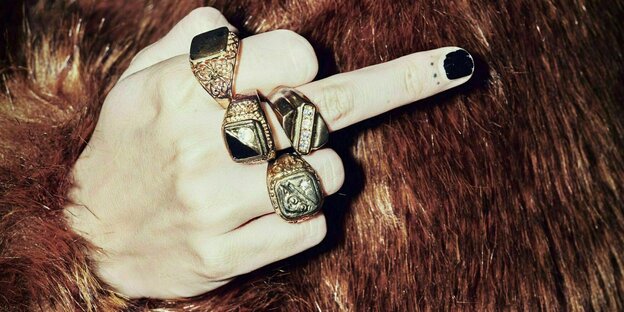The Slavic Core trend ignores the diversity of Eastern Europe. Given Russia's war of aggression against Ukraine, it could have serious consequences.

The trend suggests the image of a woman who primarily cares about material things, i.e. expensive furs and gold jewelry. Photo: Oscar Wettersten/plainpicture
The women wear eye-catching fur hats, thick fur coats and decadent gold jewelry in the videos that have recently gone viral on Tiktok and Instagram under the hashtag Slavic Core. German celebrities also danced to the 2003 Russian song “Moy marmeladniy” by Katya Lel in these videos. Palina Rojinski wrote in her caption that the song plays at every party. Content creator Richard Cwiertnia, known for his satirical depiction of the “father of the Eastern Bloc,” commented: “Russian music just vibrates like no other.”
In the rest of the comments there was a lot of criticism of this trend, a lot of solidarity with Ukraine, but also that the video was great and that not everything should be politicized. Other influencers, who at first glance have no connection with Russia, used this song, fur hats and fur coats with slightly ironic movements to reach out and like.
But the Slavic core or the Slavic era existed before this trend. In general, the term describes a style of representation that focuses on the aesthetics of Slavic culture. However, it repeatedly uses superficial and outdated clichés. Eastern European women are objectified and reduced to their appearance. It almost seems cartoonish and suggests the image of a woman who is primarily concerned with material things, i.e. expensive furs and gold jewelry.
From a feminist perspective, the problem is not using or liking these things, but rather that they are automatically associated with them and the characteristics associated with them due to their origin. Because although the cartoons want to convey irony, in these videos the clichés are equated with identifying features of Slavic culture, which is more diverse than this trend suggests.
trivialization and romanticization
The fashion elements are reminiscent of the early 90s. A time when the Soviet Union fell apart and more and more countries gained their independence. A fact that today's Russia does not consider legitimate. This trend creates a nostalgia for the old, what was and what could be again if Putin were just allowed to do his thing. The terrible scope of such a fantasy can be seen in the Russian bombing of Ukraine.
The trend and the term Slavic core equate all the states of Eastern Europe. There are certain similarities, for example, the different national languages largely belong to the same language family, and the past under communism may also have left traces, for example in architecture. But it is absolutely fatal to equate only Poland and Belarus, not to mention Russia and Ukraine. The countries of the former Eastern Bloc differ significantly from each other politically, linguistically, culturally, socially and economically.
On the other hand, equating them makes it seem logical that countries with the same or similar past are still connected through them today. This refers to the Soviet Union, which placed numerous Eastern European countries under the hegemonic power of Russia during communism. Or colonized. Russia's role as “big brother” is becoming socially acceptable again. Or that it would have territorial claims on independent states.
In Slavic Core, different realities are mapped onto an aesthetic that corresponds more closely to the Russian self-image. Since Russia's attack on Ukraine, Ukraine has been fighting against being Russia and being equated with that country. She fights against the territorial, political, cultural and linguistic oppression of this country. Because that was exactly the case in the Soviet Union.
Trends have the advantage that they are entertaining and temporary. Following seemingly harmless trends without thinking can still have serious consequences. The Slavic Core trend trivializes and romanticizes Russia, valorizes it, presents it as relaxed and fun. Even if not everyone who danced to this trend and liked and shared the videos automatically approves of the war or Russia, but they probably actually approve of themselves. If I have been attracted by the lightness of the rhythms, this example shows that trends should be viewed with caution.